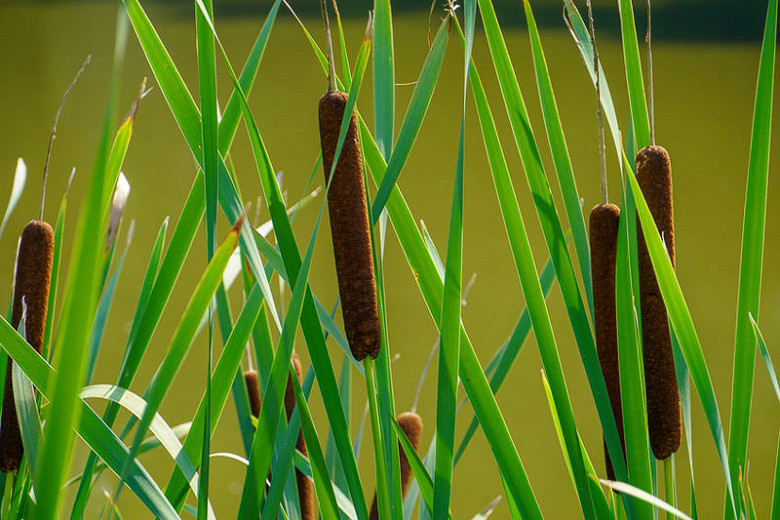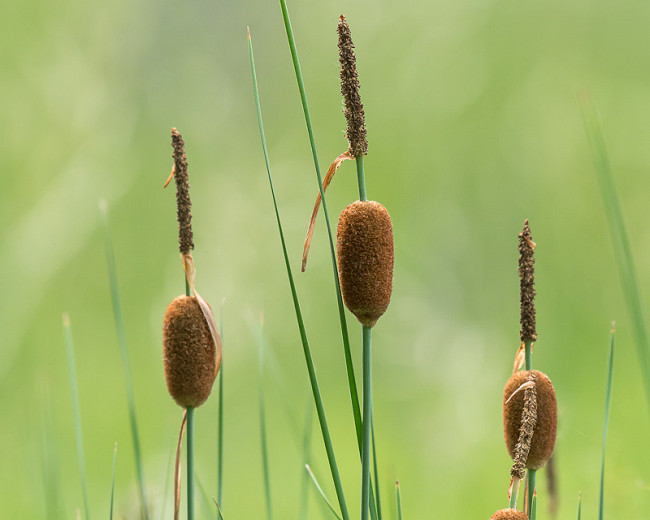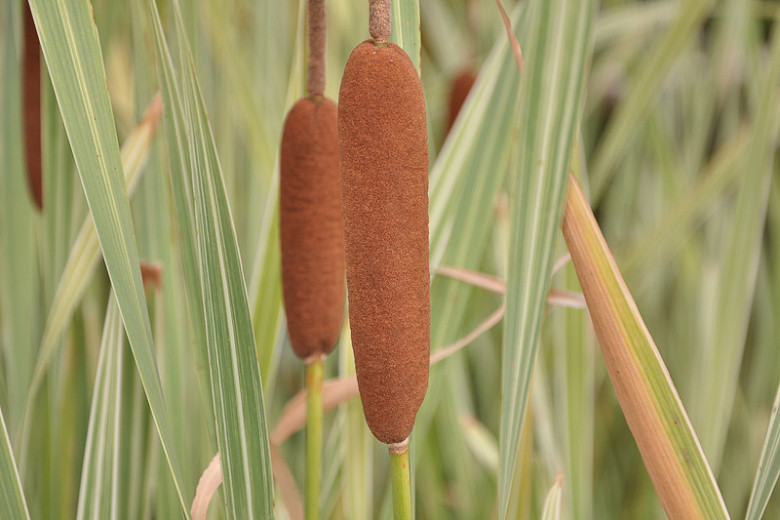Typha latifolia (Broadleaf Cattail)
Typha latifolia (Broadleaf Cattail) is a vigorous, marginal aquatic perennial forming a dense clump of stout, cylindrical, and unbranched stems up to 7 ft. long (210 cm). The narrow, upright, linear, light green leaves turn golden brown in the fall. In spring to early summer, the plant bears cylindrical inflorescences composed of tiny male, staminate flowers in the upper portion and female, pistillate flowers below. Over 1000 flowers may be produced on one plant. The male flowers are golden yellow at the time they shed their pollen, then they disintegrate, leaving a naked stalk tip. The densely packed female spike turns from green to rich brown as the seeds mature. The fertilized flowers produce single-seeded, nutlike achenes with long, slender hairs that allow for wind and water transport of the seeds. The fruiting spikes usually persist to early winter before disintegrating. They are widely popular for cut flower arrangements. Broadleaf Cattail has tough, stout, coarse, and extensive rhizomes. It spreads to form dense colonies in shallow water, where it provides a favorable habitat for red-winged blackbirds, as well as other marsh birds, and muskrats. Nutria, muskrats, and beavers enjoy the shoots and roots, while teal ducks or finches eat the seeds. Native to marshes, swamps, and wetlands in North America, Europe, and Asia, Broadleaf Cattail can be used as an accent plant or for a thick privacy screen. It can grow in a pond, water garden, bog garden, or in a container that does not drain. Broadleaf Cattail is aggressive and should not be introduced without thought as to how to control it. Site plants carefully because the roots go deep and are hard to eradicate once established.
- Grows up to 4-7 ft. tall and wide (120-210 cm).
- A full sun to light shade lover, this plant thrives in shallow water, 12 in. deep (30 cm). Outside of containers, rhizomes can spread rapidly to form colonies when happy.
- No serious pest or disease issues.
- Propagate by root division or by seed.
- Native to North America, Europe and Asia.
Requirements
| Hardiness | 3 – 10 |
|---|---|
| Plant Type | Aquatic Plants, Perennials |
| Plant Family | Typha – Cattails |
| Exposure | Full Sun, Partial Sun |
| Season of Interest | Spring (Early,Mid,Late)Summer (Early,Mid,Late)FallWinter |
| Height | 4' – 7' (120cm – 210cm) |
| Spread | 4' – 7' (120cm – 210cm) |
| Spacing | 48″ – 84″ (120cm – 210cm) |
| Water Needs | High |
| Maintenance | Average |
| Soil Type | Clay, Loam |
| Soil pH | Acid, Alkaline, Neutral |
| Soil Drainage | Poorly Drained |
| Characteristics | Showy, Evergreen |
| Native Plants | United States, Alaska, California, Midwest, Illinois, Indiana, Iowa, Kansas, Michigan, Minnesota, Missouri, Nebraska, North Dakota, Ohio, South Dakota, Wisconsin, Northeast, Connecticut, Delaware, Maine, Massachusetts, Maryland, New Hampshire, New Jersey, New York, Pennsylvania, Rhode Island, Vermont, Pacific Northwest, Idaho, Oregon, Washington, Rocky Mountains, Colorado, Montana, Utah, Wyoming, Southeast, Alabama, Arkansas, Florida, Georgia, Kentucky, Louisiana, Mississippi, North Carolina, South Carolina, Tennessee, Virginia, West Virginia, Southwest, Nevada, Arizona, New Mexico, Oklahoma, Texas |
| Tolerance | Wet Soil |
| Attracts | Birds |
| Garden Uses | Bog Gardens, Ponds and Streams, Rain Gardens, Water Gardens |




